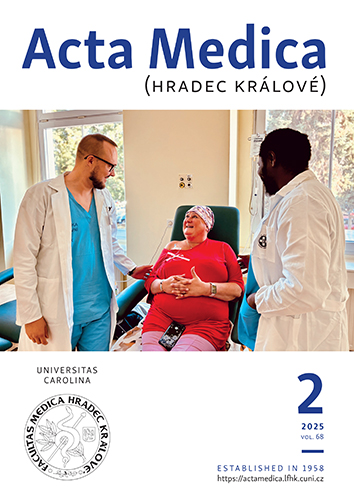ACTA MEDICA, Vol 57 No 2 (2014), 56–61
The VEGF and BMP-2 Levels in Patients with Ankylosing Spondylitis and the Relationship to Treatment with Tumour Necrosis Factor Alpha Inhibitors
Marian Tošovský, Petr Bradna, Ctirad Andrýs, Kateřina Andrýsová, Eva Čermáková, Tomáš Soukup
published online: 09. 02. 2015
abstract
Introduction: Ankylosing spondylitis (AS) is an inflammatory rheumatic disease characterized by the devel-opment of osteoproductive changes in the spine which could possibly result in ankylosis. Treatment with tumour necrosis factor alpha (TNFα) inhibitors has proved to be an important step forward in the treatment of this disease, but for the time being it is not clear whether it favourably influences radiographic progression of the disease. Vascular endothelial growth factor most probably plays a role in the development of osteoproductive changes and recently its predictive influence on radiographic progression has been demonstrated. Bone morphogenic protein 2 (BMP-2) participates in the regulation of bone proliferation and its increased serum level has been demonstrated in patients with advanced AS and correlated with the degree of radiographic changes. Aim: The study aims to evaluate the VEGF and BMP-2 levels in patients with ankylosing spondylitis and how these levels relate to the concurrent treatment with TNFα inhibitors. Methods: Sera were evaluated from patients at the Rheumatologic Clinic of the Hradec Králové Faculty Hospital who fulfilled the modified New York Criteria for AS (n = 55). In these patients, the parameters of the activity of the disease (BASDAI = Bath Ankylosing Spondylitis Disease Activity Index, CRP = C-reactive protein) and the concurrent therapy (TNFα inhibitors, n = 21, vs. non-anti TNFα, n = 34) were recorded. The levels of VEGF and BMP-2 were analyzed using the ELISA method. Results: In patients treated with TNFα inhibitors, a significantly lower VEGF level was found when compared to untreated patients (140.3 (109.4; 262.2) vs. 261 (172.4; 396.6) pg/ml; p = 0.02). No difference was found between BMP-2 levels in both groups (treated vs. untreated patients) (254.8 (2301; 267.3) vs. 261.1 (248.6; 273.5) pg/ml; p = 0.24). A correlation analysis did not reveal any relationship between VEG F and BMP-2 (r = 0.057; p = 0.68). Serum levels of VEGF correlated with serum levels of CRP (r = 0.56; p = 0.00001) and the BASDAI value (r = 0.33; p = 0.015). Conclusion: Significantly lower VEGF levels were found in patients treated with TNFα inhibitors versus the untreated patients. These findings are in harmony with some hitherto published analyses and may give evidence of a favourable effect of TNFα inhibitors on radiographic progression. Neither influence on the BMP-2 level by treatment with TNFα inhibitors nor correlation with VEGF levels was demonstrated.
keywords: Ankylosing spondylitis; Axial spondyloarthritis; Vascular endothelial growth factor; Bone morphogenic factor 2; Radiographic progression

The VEGF and BMP-2 Levels in Patients with Ankylosing Spondylitis and the Relationship to Treatment with Tumour Necrosis Factor Alpha Inhibitors is licensed under a Creative Commons Attribution 4.0 International License.
210 x 297 mm
periodicity: 4 x per year
print price: 150 czk
ISSN: 1211-4286
E-ISSN: 1805-9694
